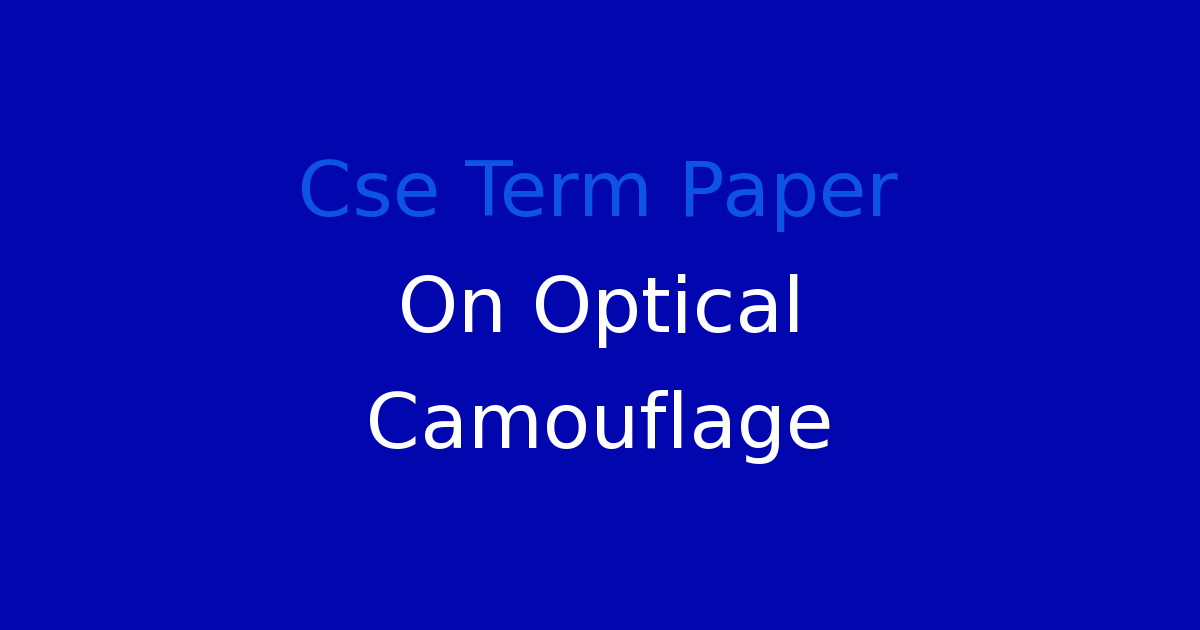Term paper on the topic of optical camouflage in the field of computer science engineering.
Introduction
In recent years, the concept of optical camouflage has garnered significant attention in the field of engineering and technology. Optical camouflage refers to the use of advanced materials and technologies to render objects invisible or transparent to the naked eye. This technology has the potential to revolutionize various industries, including defense, surveillance, and entertainment. In this term paper, we will explore the existing system of optical camouflage, identify its limitations and disadvantages, propose a new system to address these issues, and discuss the potential advantages and features of the proposed system.
Problem Statement
The existing system of optical camouflage relies primarily on the use of specialized cameras and projectors to create the illusion of invisibility. However, this system has several limitations that restrict its practical applications. One of the key challenges is the limited range of objects that can be camouflaged effectively. Additionally, the current system is bulky, expensive, and requires significant technical expertise to operate.
Existing System
The existing system of optical camouflage typically involves the use of cameras to capture the background scenery behind an object and project it onto the object’s surface using specialized projectors. This creates the illusion of transparency or invisibility when viewed from a specific angle. While this technology has been demonstrated in controlled environments, such as research labs and tech demos, its real-world applications are limited by several factors, including technical constraints, cost, and practicality.
Disadvantages
The disadvantages of the existing system of optical camouflage are significant and have hampered its widespread adoption. Some of the key drawbacks include:
1. Limited Range: The current system is only effective for camouflaging relatively small objects at close range. Larger objects, such as vehicles or buildings, are much more challenging to conceal using this technology.
2. Technical Complexity: The operation and maintenance of the existing system require specialized knowledge and expertise, making it inaccessible to the average user.
3. Cost: The high cost of the components and materials used in the current system makes it prohibitive for many potential applications, especially in commercial settings.
4. Power Consumption: The projectors and cameras used in the existing system consume a significant amount of power, limiting their practicality for mobile or remote applications.
Proposed System
To address the limitations of the existing system of optical camouflage, we propose a new system that leverages recent advancements in materials science and engineering. The proposed system will utilize lightweight, flexible, and energy-efficient materials to create a more practical and versatile solution for rendering objects invisible or transparent.
Advantages
The proposed system of optical camouflage offers several key advantages over the existing system. Some of the primary benefits include:
1. Enhanced Range: The new system will be capable of camouflaging a wider range of objects at varying distances, making it more versatile and adaptable for different applications.
2. Simplified Operation: The proposed system will feature a user-friendly interface and intuitive controls, making it accessible to a broader audience without specialized training.
3. Cost-Effective: By utilizing affordable materials and components, the new system will be more cost-effective than the existing system, opening up new opportunities for commercial deployment.
4. Energy-Efficient: The proposed system will be designed to minimize power consumption, enabling longer use times and improved mobility for a wider range of applications.
Features
The proposed system of optical camouflage will include several advanced features to enhance its performance and usability. Some of the key features of the new system will include:
1. Lightweight and Flexible Materials: The use of lightweight and flexible materials will make the new system more portable and adaptable for various environments and applications.
2. Enhanced Camouflage Effectiveness: The advanced materials and technologies incorporated into the new system will improve the effectiveness and realism of the camouflage effect, creating a more convincing illusion of invisibility.
3. Intuitive Controls: The user interface of the proposed system will be designed for ease of use, with intuitive controls and customizable settings to optimize performance for different scenarios.
4. Enhanced Durability: The materials used in the new system will be selected for their durability and resilience, ensuring long-lasting performance in diverse conditions and environments.
Conclusion
In conclusion, optical camouflage is a fascinating technology with the potential to revolutionize various industries and applications. While the existing system of optical camouflage has several limitations and disadvantages, the proposed system offers a more practical, cost-effective, and versatile solution for rendering objects invisible or transparent. By leveraging recent advancements in materials science and engineering, we can overcome the challenges of the old system and unlock new possibilities for the future of optical camouflage.

